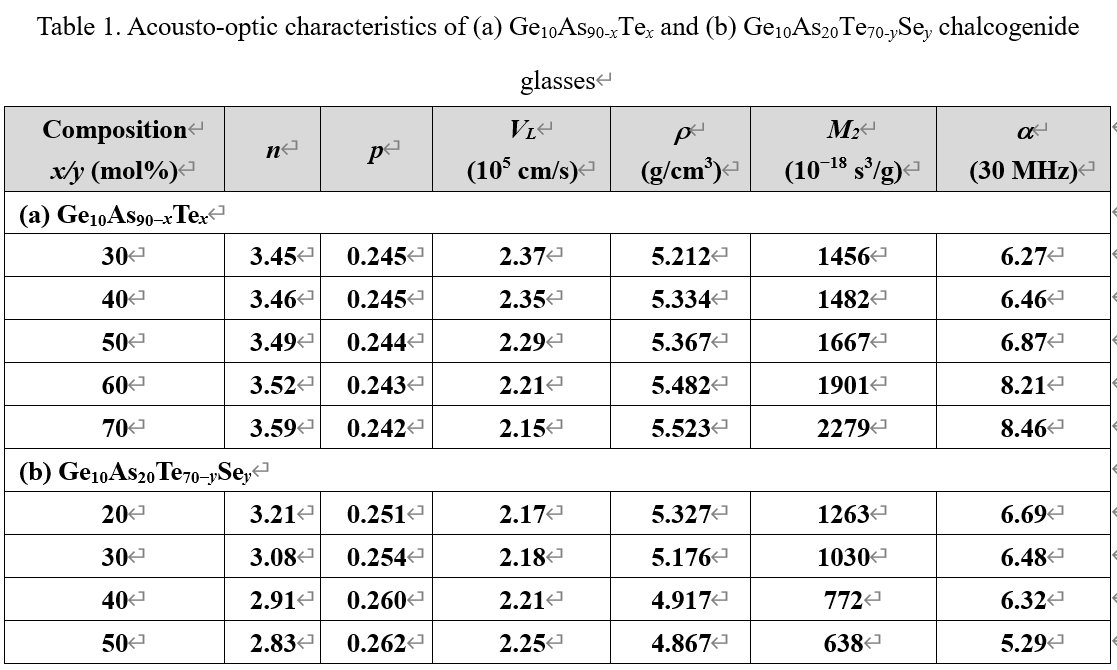Recently, Zhenfei Cao (first author), a postgraduate student in our laboratory, and professor Shixun Dai (first corresponding author) have published an article entitled “Investigation of the acousto‐optical properties of Ge–As–Te–(Se) chalcogenide glasses at 10.6 mm wavelength” in Journal of the American Ceramic Society (Journal of the American Ceramic Society. 2021, https://doi.org/10.1111/jace.17767).
Acousto-Optic (AO) devices are designed to quickly and effectively control the frequency, direction and intensity of the laser and have been produced such as acousto-optic modulators, acousto-optic Q switches, acousto-optic deflectors, etc. To date, commercial acousto-optic devices have been effectively put into practical use in the ultraviolet, visible and near-infrared bands. In the mid-to-far infrared band, only TeO2 crystals and Ge single crystals are widely used as acousto-optic materials. TeO2 crystal has a high acousto-optic figure of merit M2 value (M2 = 1200×10-18 s3/g) at 3.39 mm, but the narrow transmission range (0.35-5 mm) limits the application of acousto-optic devices in the far infrared band. Single crystal Ge has a wide transmission range (2-20 mm), but the relatively low M2 value (M2 =120×10-18 s3/g) at 10.6 mm limits the improvement in acousto-optic performance. In order to improve the performance of mid- and far-infrared acousto-optic devices, new acousto-optic materials have become a hot spot for many researchers. Chalcogenide glasses have high M2 due to its high refractive index and low acoustic velocity, and its wide infrared transmission range and easy production of large-size samples make it a new kind of excellent acousto-optic media. Through the adjustment of the glass composition, its M2 value is 2~3 orders of magnitude higher than that of standard acousto-optic glass (SiO2), which can effectively compensate for the defect that the acousto-optic diffraction efficiency (h) decreases due to the increase in wavelength.
In this paper, the physical, thermal, optical and acoustic properties of Ge10As90-xTex (x = 30, 40, 50, 60, 70 mol%) and Ge10As20Te70-ySey (y = 20, 30, 40, 50 mol%) chalcogenide glasses were compared, as well as the relationship between acousto-optic properties and composition at 10.6 mm wavelength. Meanwhile, the acoustic attenuation (a) at different ultrasonic frequencies and the M2value of Ge-As-Te-(Se) chalcogenide glasses were characterized by the pulse echo method (Fig. 1(a)) and the Dixon-Cohen comparison method (Fig. 1(b)), respectively. The research results showed that the M2 value of Ge10As90-xTex chalcogenide glasses increased with the increase in Te content (as shown in Table 1). Ge10As20Te70 glass reached the maximum value of M2 (M2 = 2279×10-18 s3/g), and its value is 19 times that of commercial single crystal Ge (M2 = 120×10-18 s3/g). However, the thermal and elastic properties of this series of glasses need to be improved, and the a values increased with the increased ultrasonic frequencies (Fig. 2(a)). For Ge10As20Te70-ySey chalcogenide glasses, its thermal and elastic properties were improved by adding Se element, and the a value (Fig. 2(b)) and M2 value of Ge10As20Te70-ySey glasses was lower than that of Ge10As90-xTex glasses, and the lowest a value at 30 MHz audio frequency is 5.29 dB/cm (as shown in Table 1). The difference in a values of the two series of chalcogenide glasses at low ultrasonic frequencies was lower than that at high ultrasonic frequencies (as shown in Fig. 2). The high M2 values of the Ge-As-Te-(Se) chalcogenide glasses compensated for the negative impact of the decrease in the acousto-optic dffraction efficiency (h) due to the increase in wavelength, and is expected to be used in low-frequency acousto-optic devices in long-wave infrared band.

Fig. 1. (a) schematic diagram of the device for measuring ultrasonic velocity VL and acoustic attenuation a by pulse-echo method; (b) schematic diagram of device for measuring acousto-optic figure of merit M2 by Dixon-Cohen comparison method

Fig. 2. Acoustic attenuation (a) curves of (a) Ge10As90-xTex and (b) Ge10As20Te70-ySey chalcogenide glasses under different ultrasonic frequencies



